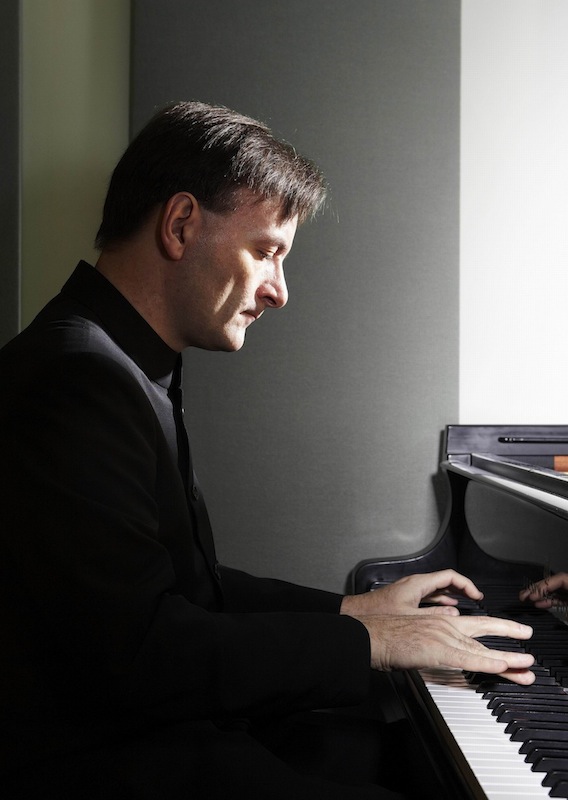Death becomes Stephen Hough’s intelligent virtuosity in Pinecrest
The pianist Stephen Hough sounded apologetic in his brief opening talk, as he described the theme of Sunday’s concert: “I suppose death, really.”
The program at Temple Beth Am in Pinecrest, he explained, contained works composed as memorials, such as Liszt’s Funérailles, as well as the Chopin sonata with its famous funeral march and a pair of Liszt’s diabolical Mephisto waltzes.
But while death was certainly in the air, there was another theme as well. The program was wholly made up of works by composers who were also great pianists—or in Bach’s case, a great organist and harpsichordist—and in this group, Hough fearlessly included himself. Between works of Chopin and Liszt, he performed his own Piano Sonata No. 4, subtitled “Vida Breve” (“Short Life”).
The role of virtuoso pianist-composer seemed to have died with Rachmaninoff, but if anyone were to revive it, Hough would be a likely candidate. A winner of a MacArthur Foundation “Genius Grant,” the British pianist is famously multitalented, having exhibited paintings, published poetry, non-fiction and a novel, and of course, composed music.
Performing in the Friends of Chamber Music of Miami series, Hough opened with Ferruccio Busoni’s famous arrangement of Bach’s Chaconne for solo violin. The Italian composer’s arrangement does much more than simply fill out the harmonies, making a distinctly pianistic version of Bach’s masterpiece.
The chaconne consists of a series of variations that reach a procession of climaxes until the theme returns for a final statement. Hough began quietly, giving himself lots of dynamic room for the grandiose climaxes to come. In his hands, the work came off as more melodic, surprisingly, than the violin original. While the violin strains to deliver Bach’s harmonies on four strings—generating a physical intensity that is part of the work’s impact—the piano does so easily, allowing Hough to focus on the melodic line.
As the variations become more complex, they lead to a series of arpeggios, and Hough built the first section to a roiling climax, with rumbling bass notes, making the most of the piano’s ability to generate orchestral power. When the opening theme returned, he played it in a stark manner that brought out the contrast to the complex variations that came before.
In the major key variations that followed, he played in a light, harplike manner, effectively teasing out the changing harmonies. The last section, which returns to a minor key for the intensifying variations that led to the end, came off as too fast however, turning Bach’s precise music into a blur that detracted from its cumulative impact.
In a brief interlude between big works, he performed Busoni’s Berceuse, playing with firm sonority in the bass as he floated unearthly harmonies with his right hand, drawing sounds that seemed to come from the piano without a trace of percussion.
In Hough’s hands, Chopin’s Piano Sonata No. 2 came off as particularly modern, from its discordant opening to the bleak tone of the funeral march and the chilling brief finale. His aggressive bass tones in the opening gave it a particularly grim and heavy sound, accentuating the dissonances that many pianists try to soften.
The famous “Marche funèbre” gained enormous depth in his interpretation. He opened with a subtle, pulse-like rhythm, rather than producing the strident dirge of many pianists. The sweet central melody came off as especially bleak in his pianissimo playing, a memory of lost happiness. Then, when the funeral theme returned, it thundered, as Hough discarded his earlier restraint and played with pealing grandeur. Hough played the bizarre finale, with its whizzing notes and abrupt ending, in a fluent rush of notes, an icily effective display of virtuosity.
After intermission came Hough’s own new sonata, which he premiered last November (oddly the only work for which he required sheet music, having played other composers’ works from memory). The single-movement work was learned and cerebral, with short motifs introduced in fugue-like passages that were developed through the rest of the piece.
It’s difficult to say on first hearing whether the sonata will have any staying power. But while the piece showed thought and compositional technique, it also displayed imagination and a strong physical drive, with the motifs developed and transformed in a compelling manner, with a firm sense of structure and musical drama.
Hough concluded with three works of Liszt. In Funérailles, he brought a thunderous bass and lyric left hand to the work, playing its central melody in a winsome Romantic manner. The Mephisto Waltz No. 4 offered huge sonorities and then a light virtuoso touch on top of its complexities. In the popular Mephisto Waltz No. 1, the pianist played with a warm sensuality in the central melody, surrounding it with a light gauze of ornamentation, played with effortless ease despite the rapidity of the notes.
As an encore, the pianist gave a wistful, elegiac performance of Chopin’s Nocturne in E Flat Major, Op. 9, no.2.
The Jerusalem Quartet performs music of Haydn, Debussy and Ravel April 17. miamichambermusic.org
Posted in Performances
One Response to “Death becomes Stephen Hough’s intelligent virtuosity in Pinecrest”
Leave a Comment
Mon Apr 1, 2019
at 12:19 pm
1 Comment






Posted Feb 27, 2020 at 1:00 pm by kyrl
Saw the same program when he played it in Oviedo in Spain on Tuesday of this week, really splendid concert